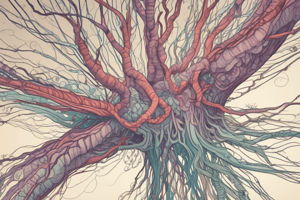Podcast
Questions and Answers
What is the main function of the dendrites in a neuron?
What is the main function of the dendrites in a neuron?
- To receive signals from other neurons (correct)
- To transmit signals away from the cell body
- To maintain the cell's function
- To release neurotransmitters into the synapse
Which lobe of the cerebral cortex is responsible for spatial awareness and processing sensory information?
Which lobe of the cerebral cortex is responsible for spatial awareness and processing sensory information?
- Temporal lobe
- Frontal lobe
- Occipital lobe
- Parietal lobe (correct)
From which layer of the embryo does the nervous system develop?
From which layer of the embryo does the nervous system develop?
- Endoderm
- Mesoderm
- Ectoderm (correct)
- Hypoderm
What is the main function of the brainstem?
What is the main function of the brainstem?
What is the process of neurons communicating with each other?
What is the process of neurons communicating with each other?
What is the main function of the myelin sheath?
What is the main function of the myelin sheath?
Flashcards are hidden until you start studying
Study Notes
Neuron Structure
- A neuron consists of:
- Dendrites: receive signals from other neurons
- Cell body: contains the nucleus and maintains the cell's function
- Axon: carries signals away from the cell body
- Terminal buttons: release neurotransmitters into the synapse
- Neurons communicate through electrical and chemical signals
- The myelin sheath, composed of fatty tissue, insulates and facilitates signal transmission
Cerebral Cortex Function
- The cerebral cortex is the outermost layer of the brain, responsible for:
- Processing sensory information
- Controlling movement and behavior
- Facilitating thought, perception, and memory
- The cortex is divided into four lobes:
- Frontal lobe: motor control, decision-making, and language
- Parietal lobe: spatial awareness and processing sensory information
- Temporal lobe: auditory processing and memory
- Occipital lobe: visual processing
Nervous System Development
- The nervous system develops from the ectoderm layer in the embryo
- The neural tube forms and eventually closes to create the central nervous system
- The neural crest cells migrate and differentiate to form the peripheral nervous system
- The neural tube differentiates into:
- Forebrain (prosencephalon): develops into the cerebrum and thalamus
- Midbrain (mesencephalon): develops into the midbrain
- Hindbrain (rhombencephalon): develops into the cerebellum, pons, and medulla oblongata
Brainstem Function
- The brainstem connects the cerebrum to the spinal cord
- It regulates essential functions, including:
- Breathing
- Heart rate
- Blood pressure
- Body temperature
- Hunger and thirst
- The brainstem consists of:
- Midbrain
- Pons
- Medulla oblongata
Synaptic Transmission
- Synaptic transmission is the process of neurons communicating with each other
- Steps involved in synaptic transmission:
- Neurotransmitter release: terminal buttons release neurotransmitters into the synapse
- Neurotransmitter binding: neurotransmitters bind to receptors on the postsynaptic neuron
- Signal integration: the postsynaptic neuron integrates the signal and generates an action potential
- Factors affecting synaptic transmission:
- Neurotransmitter type and concentration
- Receptor density and type
- Synaptic plasticity: the strengthening or weakening of synaptic connections
Studying That Suits You
Use AI to generate personalized quizzes and flashcards to suit your learning preferences.




